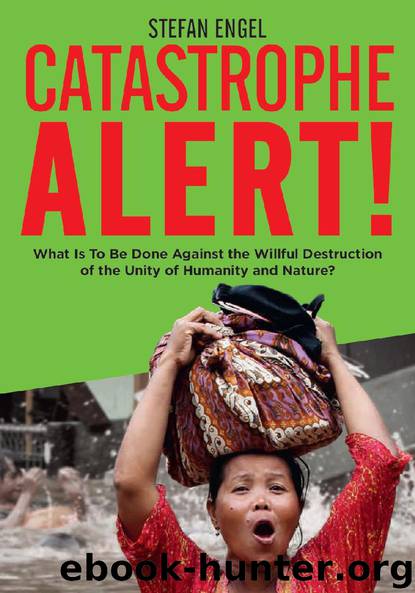Catastrophe Alert! by Stefan Engel

Author:Stefan Engel
Language: eng
Format: epub
Publisher: Neuer Weg
Published: 2016-11-15T00:00:00+00:00
B.9. Irresponsible Use of Nuclear Energy
Radioactivity and nuclear energy
In 1896 the French physicist Henri Becquerel discovered by chance that a photographic plate became exposed in the presence of uranium salts even though the plate was shrouded in black paper. This was the first step in the discovery of radioactivity. By 1914 research had led to discovery of the three principal types of radioactive emission, namely alpha, beta and gamma radiation.
Alpha particles are identical with high-speed helium nuclei while beta particles are electrons with very high velocity. Gamma radiation on the other hand is an energy-rich electromagnetic wave similar in nature to X-rays, with the difference that it has a much greater frequency.
By 1903 Ernest Rutherford and Frederick Soddy had been able to demonstrate that radioactivity is a transformation process taking place in the nuclei of atoms in which radiation is emitted and one chemical element is turned into another. This was not only a brilliant advance towards a deeper understanding of radioactivity, but also a major triumph for the dialectical-materialist world outlook in modern natural science.
Radioactivity is a random process. It is not possible to say in advance which nucleus will decay when. Rutherford and Soddy discovered the basic statistical law of radioactivity: no two elements behave identically although each has its own characteristic time in which the number of nuclei remaining is halved. As the number of nuclei remaining decreases, so does the intensity of the radiation. Each element has its own specific half-life.
Originally, all radioactive materials which were studied occurred naturally. However, in 1934 Irène and Frédéric Joliot-Curie created an artificial element which never occurs in nature. They had made a radioisotope. 37
Otto Hahn and Fritz Strassmann became the first physicists to split the nucleus in 1938. When a uranium-235 nucleus is bombarded by neutrons it divides into two fragments, barium-144 and krypton-89, along with three new neutrons. These liberated neutrons can cause a chain reaction. The products of this nuclear fission (as this division process is called) are themselves radioactive. One of the products of a collision between a neutron and uranium-238 is plutonium-239, which is not only radioactive but also extremely poisonous. This plutonium-239 can itself serve as the starting point of a chain reaction.
It is exactly these types of nuclear reaction which provide the basis for the application of atomic energy. In a nuclear warhead an uncontrolled chain reaction takes place, causing an explosion. In nuclear power stations the rate of this chain reaction is controlled and the resulting heat energy is used to continuously generate electricity.
The reactions occurring in nuclear explosions and nuclear reactors give rise to a wide range of radioactive isotopes, for example krypton-85, strontium-90, iodine-129, iodine-131, cesium-134 and cesium-137.
Natural and artificial forms of radioactivity are essentially the same, although one qualitative difference is their radiation. The activity of a radioactive isotope is measured in becquerel 38. Higher activities are associated with short halflives since, if the half-life is short, then more nuclei decay in a given time.
Naturally occurring radioactive elements are the remnants of the creation of the solar system and tend to have very long half-lives.
Download
This site does not store any files on its server. We only index and link to content provided by other sites. Please contact the content providers to delete copyright contents if any and email us, we'll remove relevant links or contents immediately.
How to Do Nothing by Jenny Odell(3199)
A Forest Journey by John Perlin(3008)
The Plant Messiah by Carlos Magdalena(2839)
Babylon's Ark by Lawrence Anthony(2489)
The ESV Study Bible by Crossway Bibles(2454)
Energy Myths and Realities by Vaclav Smil(2408)
Fatal Storm by Rob Mundle(2106)
Abbey in America by Murray John A(2031)
Witness Tree by Lynda V. Mapes(1871)
Brokeback Mountain by Annie Proulx(1741)
Client Earth by James Thornton(1711)
Shadows on the Gulf by Rowan Jacobsen(1703)
Coming Back to Life by Joanna Macy(1670)
Cosmos by Carl Sagan(1661)
Water Rights and the Environment in the United States by John Burch(1625)
Mycelium Running: How Mushrooms Can Help Save the World by Paul Stamets(1603)
Ten Billion by Stephen Emmott(1589)
The overachievers by Robbins Alexandra(1511)
Ecological Intelligence by Daniel Goleman(1434)
